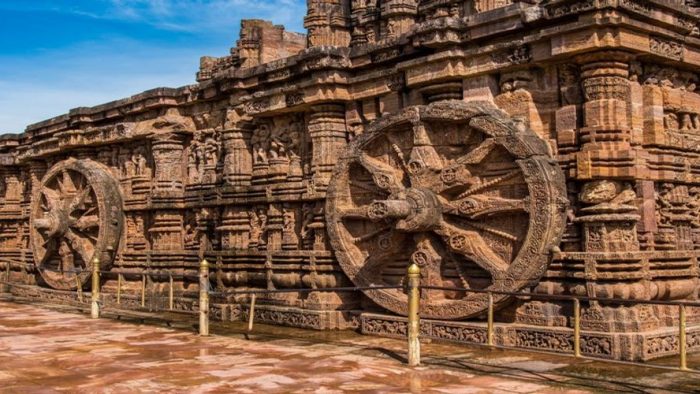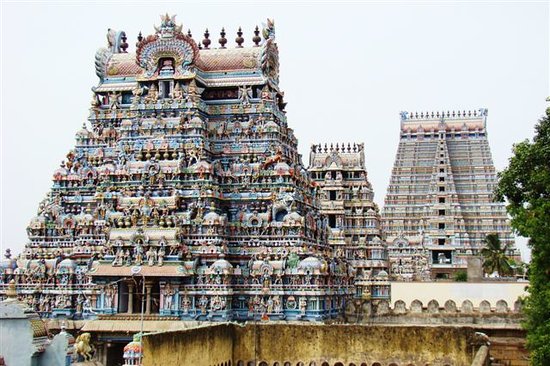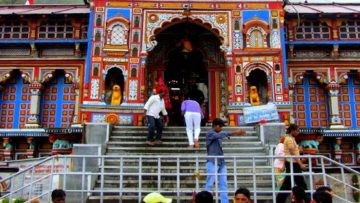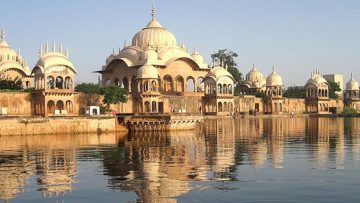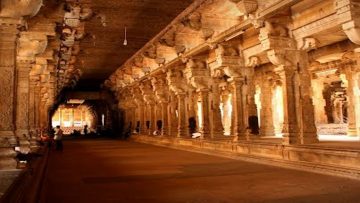This series was first published on Indiafacts and is being reproduced here. Read parts I, II and III.
Over history, the Indian temples have received great patronage and protection from the Indian Kings, they have also withstood great onslaughts. While nothing much is known about the way some of the earlier invaders, starting from the Persians to the Greeks, Sakas and Hunas treated the Indian temples, the Islamic invasion of India from the middle of seventh century singularly targeted the Indian temples for attack. This subject has been discussed at some length in a well-known study29, which also gives a list of about 2,000 Muslim monuments of today, which stand on the sites of deliberately demolished temples and in the construction of which materials from the demolished temples have been used.
What is perhaps noteworthy is that nearly 600 entries in the above list (30% of the total) happen to be located in the three southern states of Andhra Pradesh, Karnataka and Tamil Nadu, regions which are commonly supposed to have largely escaped from the Islamic invasion and conquest. Another important point which is noteworthy is that, it is not the so called Hindu temples alone which got destroyed in this onslaught.
As has been noted in the above study, in the first half of seventh century, Hiuen Tsiang visited about 95 Buddhist centres in India each of which had between 50 to 500 Sangharamas and 1,000 to 10,000 Monks. The destruction of perhaps 50,000 or more Buddhist Viharas is also co-terminus with the destruction of the large number of Hindu temples in India.
Many temples however did survive the Islamic invasion and rule. The resurgence of sanatana dharma in the Vijayanagara Samrajaya and its successors in south India from the 14th century onwards, and later under the Hindavi Svarajya of Chatrapati Shivaji in the seventeenth century, and the rise of many regional kingdoms in north India which led to the end of Mughal rule in the eighteenth century, did restore the functioning and to some extent even the glory of our temples in many parts of India. This is borne out by several accounts in the eighteenth century of the functioning of our temples in various regions prior to the establishment of British rule there. We shall here present a few instances of the manner of functioning of our temples prior to the onset of British rule.
Integrating the regional polity: The great temples of Chengalpattu (c.1770)
A detailed picture of the way the temples and other cultural and religious institutions were maintained in the pre-British Indian polity in the 18th century is available from the detailed records of the survey conducted by the British, during 1767-74, of over 2000 localities in the Chengalpattu region, around the city of Madras.30 The survey records show that for the upkeep of various services and functions essential to the polity two kinds of arrangements were made. Firstly, a part of the cultivated lands of the locality, amounting to nearly a quarter of the cultivated lands, was assigned as maniyam, lands whose revenue was assigned to the support of various functions and services. A more significant arrangement involved the allocation from the grain produce, which were known as swatantrams and merais, which together amounted to a third of the total produce.
In this way most of the services and functions were provided for and arranged at the locality level itself. Apart from the local temples and the cultural and religious establishment which received a share in the grain produce from their locality, there were a number of major religious and cultural institutions of the region which received a share of produce from several localities.
These allocations were in the form of merais. There were about 25 great cultural institutions which received a share of grain produce from more than 30 localities. The greatest of such institutions was the Varadaraja Perumal Temple at Kanchipuram which received a share from over 1,250 localities.
Temples were not the only cultural centres maintained thus. There were great Mathams such as “Kubhakonam Chikkodeyar”, Jagadguru Sankaracharya of Kanchi Kamakoti Pitham then residing at Kumbhakonam, who received shares from over 300 localities. There were Muslim places like that of the Santhome Pirjada who received a share in the produce of over 100 localities. The Choultry at Tiruvottriyur received a share form nearly 50 localities. Thus the localities, while functioning as “self-sufficient autonomous republics”, were knitted together into a larger polity through the great cultural and religious institutions, apart from other administrative and military mechanisms.
The way the merais were received by these great temples is indicated by the following statement of a later Collector of Chengalpattu in 1840s:31
When the villages were originally assigned for the support of the institutions that which was given was, merely the proportion of the grain, or its equivalent in money which would accrue to the Government revenue, and … the collection of the revenue was then left in the hands of the persons controlling the affair of the temples &c …
While this could have been the situation at the time of the Chengalpattu survey around 1770, the situation changed drastically soon. The British Government as a matter of deliberate policy did not allow the great regional institutions of Chengalpattu polity to continue any direct dealings with the various localities of the region. The first Collector of Chengalpattu, Lionel Place, noted in his Report of 1799 that, soon after he became the Collector, he took over the “management of the funds of all the celebrated pagodas” into his own hands and allotted the expanses of the temples for their festivals and maintenance. By 1801, these were converted to “fixed money allowances” under a “permanent settlement”.32 Incidentally, as per Places accounts, the total merei was about 35%, and the temple merei about 4%, of the government share of the produce. They were estimated to be about 13.5% and 1.5% of the total or gross produce of the district.
Supporting a Great Establishment: Sri Ranganathaswami Temple (c.1818)
In response to the instructions of the Madras Board of Revenue, the Collector of Trichnopoly, Mr. C.M.Lushington sent a report33 in 1818, on the temples in his district, in which he included a detailed statement on the income and establishments of the “three principal temples”, Ranganathaswami temple at Srirangam, Jambukesvaraswami Temple at Tiruvanaikkaval and Tauyumanavaswami temple at the Rock Fort. As regards the importance of the Ranganathaswami temple, the Collector noted that Srirangam is held by the Hindus as a most holy place and that over a million persons assemble during the major festivals.
The Collector gave an inventory of the “property and articles” (jewels and other valuables) belonging to the temple whose value, he noted, “is estimated at the immense sum of SPs 2,21,664 – 4 – 3”. The collector’s report also includes a list of “persons employed in performing the ceremonies”. The total number of these temple functionaries adds up to 820 for the Sri Ranganathaswami temple, 201 for the Jambukeswaraswami temple and 146 for the Tayumanvaswami temple.
The list for Ranganathaswami temple includes 6 Sthalattars, 20 Archakas, 20 Adhyapakas, 20 Veda Parayanadars, 54 Sattanians, 20 Accountants, 80 Devadasis, 27 Musicians, 7 Potters, 5 Masons, 10 Sweepers and 90 “Brahmins attending in the pagoda”.
The Dharmasastra texts declare that the annadana, the Indian discipline of feeding anyone who happens to come at ones door is sadavrata, an observance, which is to be undertaken at all times and places
Unfortunately the report does not include any statement on the endowments or payments made to these temple functionaries. Such information is available for some of the smaller temples in the Baramahal area (later Salem District) at the time of British take over in the 1790’s. For instance, in the case of the Kshireshvaraswami temple in Palakkodu (in the present day Dharmapuri District), the Baramahal Records34 mention that the total income of the temple in 1793 was Chakrams 166-6-0, of which 46-6-0 were utilised for temple ceremonies. The rest were utilised towards emoluments of about 35 functionaries, which varied from about ½ chakram received by each of the four “masalgies” and 1 chakram which was received by each of the six “porters”, to 6 chakrams received by the “parpattegar” and by each of the two archakas.
Ensuring that no surplus remains: Sadavrat at Kedaranath (c.1800)
The Dharmasastra texts declare that the annadana, the Indian discipline of feeding anyone who happens to come at ones door is sadavrata, an observance, which is to be undertaken at all times and places. The titrtha-kshetras, the pilgrimage centres widely dispersed all over India, had large public endowments for the purpose of sadavrata, for free distribution of food to everyone. In the great kshetras of Badarinath and Kedaranath it was the Kings of Nepal who had made large sadavrat endowments in the seventeenth and eighteenth centuries.
One of the Sasanas of Maharajah Rama Bahadur Saha35 in 1797 grants the entire revenues of the Pargana of Mahasuri for sadavrata at Kedarnath and for the requirements of the daily worship at the temple. It stipulates 12 chittaks of rice, 2 chittaks of dhal, and 2 tolas each of salt and ghee are to be given to each of the about 25,000 pilgrims who visited Kedarnath every year.
One of the important features of the above Sasana is that it specifically lays down that any surplus which remained after defraying the above expenses was to be accumulated annually and spent in the Kumbhamela (at Hardwar) which takes place every twelfth year. This is based on the classical Indian principle that the state or public institutions were not to accumulate surpluses and ought to periodically distribute the entire accumulations away. We are in this connection reminded of the great Moksha ceremony performed by Raja Harshavardhana in the dana-kshetra of Prayaga, in which the entire royal treasury was distributed amongst people as charity.
Thriving on offerings by devotees from all over India: Tirupati Temple (c. 1800)
The wealth of the Sri Tirumala & Tirupati Devasthanams has always been legendary. This temple had somehow escaped Mohammeden invasion till mid-17th century. Around that period, the region came under the rule of Golkonda kings. It has been noted by Manucci, the contemporary Italian observer, that even Aurangzeb did not dare attack the temple in 1687 because he feared a widespread popular reaction.36
The fabulous riches of Tirupati temple, especially the wealth of gifts and offerings made to it by all class of devotees from all over India, was widely noted by European observers in the 16th and 17th centuries. The account of Gaspar Correa of his visit in 1534, notes the large congregation at the temple during an utsavam:37
I have seen this festival (of the full moon of August) and the fair that is held on that day, this pagode-house being located in a large field, where people begin to gather with their bundles of goods fifteen days in advance, where three or four million people assemble, amongst whom there would be three hundred or four hundred thousand on horse, where one can find all the nations of people in the world, and as many goods as one can name from peoples mouths, in which I affirm that all the things in the world, nay in the universe can be found, and of each thing as much as one is searching for. I will write of only one thing here as the greatest achievement that I can relate, and it is this. When these peoples go to do their adoration at the pagode, they go washed and perfumed with sandal, dressed in their fine clothes, and arrayed with their gold jewellery, and the men shave their heads with a razor, leaving no more than a long thin tuft…And since there are so many people, as I have said, there are enough barbers to suffice for them, who are all set apart below some large trees, and they shave one head for only one copper coin which is called caixa [kasu]…
There is a Jesuit account of the Goanese ambassador being received by King Venkatapatiraya in Tirupati in 1602:38
The King was at Trepeti, which is a city two leagues from Chandegri, very beautiful and large and like another Rome for this Gentility [Hindus], on account of a greatly venerated pagoda that is there, where from this entire Orient there gather innumerable people, who come with great devotion and offerings to visit this demon which they call Permal…
There is the more detailed account of Abraham Rogerius, the Dutch Missionary at Pulicat in the 1640s:39
Some day’s journey from Paliacattta [Pulicat] is the very famous Pagode Tripeti, which has three festivals yearly. One is in September; at which time there is a great confluence there-wards from all directions, particularly of the Soudraes [Sudras], or common folk; who all come with gifts. The second is in December. At which time one finds for the most part Bramines with their gifts. The time of the third festival I am unable to ascertain. So that since, Tripeti has so many visits, it must necessarily have many incomes. It is also said that this Pagode yearly would have an income of 60, 70, 80 thousand pagodas all of which result from the gifts and offerings that are brought here. Since these Heathens do not come there with empty hands, but to discharge by means of gifts the promises they have made to the Pagode, on the occasion of recovering their good health, or to give thanks for some other benefit received, so that this Pagode has become extremely powerful and rich….the Kings used to allow the Pagodes to keep these, and nothing was taken out of the treasury, unless it were needed for the upkeep of the Pagode…
The Tirupati region passed on to the rule of the Nawabs of Arcot in the first half of 18th century. According to the British records compiled around 1800, the Mohammedan rulers started the system of blackmail, known as “renting out” the temple in “return” to the protection offered to the institution. This led to the introduction of various types of pilgrim taxes and fees for “sevas” in the temple. Apart from this, the devotees continued to shower Sri Venkatesvara with kanikais or offerings.
On the death of Nawab Anwaruddin in 1749, the British extended support to Muhammad Ali Wallajah for being installed the Nawab of Arcot and, in return, he assigned the revenues of Tirupati, estimated to be around 2.5 lakh rupees, to the British. The offerings of the devotees to the temple continued to be a major source of revenue for the British for nearly hundred years.
The Tirupati area came under direct British rule after the death of Mohammad Ali’s son in 1801. It was made a part of the North Arcot District and the temple came under the direct management of the Collector. One of the accounts of that time mentions that the temple owned 187 villages of which 40 belonged to the various temple functionaries and 124 were under the management of palayakkarars.40 A detailed report on the temple and its finances was submitted by the Collector Stratton in 1803, wherein he also noted:41
Three principal Gopurams or portals are erected on the slant of the hill on the road leading to the pagoda which Hindoos only are allowed to visit, all other castes being restricted from passing the portal which is erected near the foot of the hill about half a mile distant from the village of Tripatty. In such veneration is even the hill held that pilgrims resorting to the pagoda prostrate themselves on the ground on first getting a sight of the range of hills connected with it…
The pagoda in which this famous idol is placed must no doubt be of great antiquity, but not being allowed to visit it, the only information I have derived on this subject appears in some degree fabulous – the Bramins of the pagoda asserting that its erection took place at the commencement of the Caliyug… of which 4903 years have elapsed. It being generally understood as written in the Bhaveesheottarum Poorana that the worship of Vishnoo will cease at the completion of 5000 years from the commencement of Caliyug, should the prophecy be fulfilled, we may in about a century more expect a material decrease in the revenue of the Tripatty pagoda.
… during the Hindoo Government the whole of the collections from the pagoda, were disbursed in religious ceremonies and that only since the commencement of the of the Mahommadan Government in the Carnatic have those charges had a limit and the surplus net revenue been conveyed into the coffers of the state.
The first and the principal source of revenue at the Tripatty pagoda is from the Canukulu [Kanika] or oblations…These oblations are frequently sent by the inhabitants residing north of the Tombudra [Tungabhadra], by means of Ghoseyns [Gosayis], but people from the rest of the peninsula either attend with their oblations in person or send them by means of relations or friends. The names of 21 Ghoseyns are registered at the pagoda who obtain flags from the idol which they carry to their different countries and which they expose for 2 or 3 months before the annual festival, when those who are desirous of accompanying them in the pilgrimage assemble in crowds round the banners of each leader and those who cannot attend in person, trust them with their oblations…
During 1823-32, the average annual income of the Temple was Rs. 181, 341, of which Rs. 108,580 was from the kanikais or offerings of the devotees, and Rs. 28, 523 was the “tasdik” allowance from the government in lieu of the resumed maniyams and merais. The average annual expenditure on the Temple was Rs. 31, 256. Excluding the other expenses also, the average net annual income to the government from the Temple was stated to be Rs. 108,167. 42
To be continued in the next part of the series.
References
36 Niccolao Manucci, Storia do Mogor, or Mogul India (1653-1708), 4 vols., rep New Delhi 1990, Vol. 3, p. 135-9
37 Gaspar Correa, Lendas, cited from Sanjay Subramanyam, An Eastern El Dorado: The Tirumala -Tirupati Temple Complex in Early European Views and Ambitions, 1534-1660, in D.Shullman Ed., Syllables of Sky, Oxford 1995, p.338-390.
38 Cited in Sanjay Subramanyam, 1995, cited earlier.
39 Abraham Rogerius: De Open-Deure tot het Verborgen Heydendom, cited from Sanjay Subramanyam, 1995, cited above.
40 Mackenzie Manuscripts, Vol. XVI, p.476 to 476-dt, cited in N.Ramesan, The Tirumala Temple, Tirupati 1981, p.462-464.
41 Report of G.Eo.Stratton dated 31.1.1803 to the Board of Revenue (Reprinted in, N.Ramesan, 1981, cited earlier, p.495-503).
42 K.T.Viraraghavacharya, History of Tirupati, Vol. II, Tirupati , 1954, p.927-8
Disclaimer: The opinions expressed in this article belong to the author. Indic Today is neither responsible nor liable for the accuracy, completeness, suitability, or validity of any information in the article.

